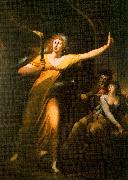
Oil On
Canvas, Real Flavor of Old Masters
|
Henry Fuseli
|
|||
|
|
|||
| Swiss-born British Romantic Painter, 1741-1825 Henry Fuseli was the first artist to command the epic literature and heroic history of northern Europe as well as the Mediterranean countries, and by his wide reading and close study of the Old Masters he equipped himself to extend the scope of history painting far beyond the traditional limits of the Bible and classical antiquity. In his speculative boldness he was a child of the Enlightenment, but he was also a fierce critic of sterile rationalism and preached the gospel of the imagination with religious fervor. Henry Fuseli was born Johann Heinrich F??ssli (in 1764 he Anglicized his name) in Zurich on Feb. 6, 1741, the son of a painter with strong religious convictions who destined him for the Zwinglian ministry. After a period of intensive theological study Fuseli was ordained in 1761 and preached his first sermon. He was a friend of Johann Kaspar Lavater, whose Aphorisms on Man he later translated into English from manuscript. Fuseli became the favorite disciple of Johann Jakob Bodmer, who in 1740 had published an essay on the wonderful in poetry that led to a literary war with Johann Christoph Gottsched in Germany and the formation of a revolutionary Swiss school which used English literature, especially Milton and Shakespeare, as a spearhead in promoting romanticism. | |||
|
|
|||
|
|
Lady Macbeth Henry Fuseli1.jpg Painting ID:: 1289 Visit European Gallery |
1784 | |
Height Width |
INS/CM |
||
|
X |
|
||
|
|
|||







